I’m safely back in NJ after a whirlwind week down in Washington DC, at the Complex Weavers Seminar. I will summarize in a succinct manner, I had a fabulous time, but alas, I am not a succinct writer, so you’ll have to read the long version below.
First, know that I never took my camera out of my fifteen pound tote bag I lugged around, even once. So there are no photos to share. My guild mate Sally on the other hand, filled her vast flash drive to capacity. And to defend Sally, there was so much to see and photograph that I probably knew that once I started, I’d spend the whole conference photographing textiles.
Secondly, and huge apologies to all of my loyal readers who are not weavers, I have to clarify my equipment and the type of weaving I do and how I got associated with the Complex Weavers in the first place.
I am a weaver. I weave very competent cloth, destined 99% of the time for garments. I have five eight shaft looms (for my non weaving readers, shafts control groups of threads; the more shafts you have on a loom, the more complex patterns you can mathematically create. ) I do not own a dobby loom, mechanical or otherwise, and I have no desire to acquire a loom with anything more than eight shafts. I’m plenty busy with what I have. That said, there are weavers that are not only weaving with computerized looms with 16, 24 or sometimes 40 shafts, but there are drawlooms and digital Jacquard looms that allow the weaver control over individual threads. I don’t go there. Not because I can’t, but because it doesn’t serve any purpose for me.
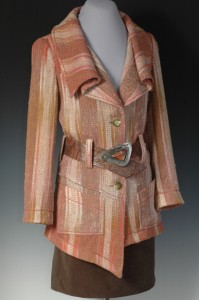 I came to Complex Weavers quite by accident, I won the Complex Weavers award last year at an exhibit with this jacket. It is a pretty complex fabric for only eight shafts. I was thrilled to win and it gave me a one year membership. And a stack of paperwork. Which I quickly filled out, mostly on my winning entry, and my jacket appeared in the spring journal.
I came to Complex Weavers quite by accident, I won the Complex Weavers award last year at an exhibit with this jacket. It is a pretty complex fabric for only eight shafts. I was thrilled to win and it gave me a one year membership. And a stack of paperwork. Which I quickly filled out, mostly on my winning entry, and my jacket appeared in the spring journal.
Now that I’m a member, I’m included in all of the correspondence, and this year, the biennial conference, no longer piggybacking Convergence, was scheduled for September in Washington DC. I can drive to that. Easily.
A call for proposals came out and after scratching my head for awhile, I decided to toss them a couple proposals and see where they took me. Much to my delight, my seminar on Advanced Techniques on the Inkle Loom was accepted, and I would be attending Complex Weavers Seminar for the first time, and as an instructor.
The Complex Weavers organization is a group of like minded individuals, who share a passion, that of the exploration of the structure of cloth. That’s a pretty targeted focus within the weaving community, and it is a testament to their mission and passion that the organization keeps growing, internationally (now over 1000 members) when other weaving venues are becoming more and more diluted. The Handweavers Guild of America, sponsors of Convergence, have spent the last 10 years trying to diversify to attract more and more new weavers or actually anyone who would support the organization and attend the conference. I don’t want to compare the two organizations. They serve different purposes and different communities. And Convergence hopes for an attendance of 2000. Complex Weavers Seminar limits its attendance to 200. There is no comparison.
And that is precisely why the Complex Weavers Seminar works. Something that small presents an intimacy that can’t be achieved in a large conference spread out over a city. When all of the attendees are housed together, and eat three meals together, and attend all the events together, there is an ability to meet and explore and share with other like minded passionate soulmates every minute of every day. At your dining table might be instructors, leading experts in historical textile preservation, PHD’s in ancient textiles and ancient techniques, and just plain ol’ folks that just really really love exploring the structure of cloth. There was the Canadian contingent, and a well represented UK contingent. There were lots of accents, and lots of sharing of “threads”.
Wandering through the conference center on the way to class you’ll pass groups chatting, hands busy, knitting, or split ply braiding, or in one case, someone working on a portable bobbin lace pillow. Samples are passed around, notes taken, and suddenly the conference is coming to an end and you think of all the things you didn’t get to explore or people you didn’t get to connect with, and you can’t wait until the next seminar in two years (near Seattle, WA FYI).
I had a great time.
I liken the format of Complex Weavers to that of the ASG conference I just attended in Houston last month. I taught, but was also able to take a number of seminars. There was the requisite fashion show, I was the moderator, and a marketplace, I sold all of my leftover handouts from previous classes this year. There was a gallery exhibit of members work, two actually, and a silent auction fundraiser. There were terrific keynote speakers, and opportunities to attend specific study groups on specific areas of interest.
One of the things that Complex Weavers needs to keep in mind, especially the teachers, is that not everyone attending has computerized looms capable of 16 shafts or greater. This isn’t AVL Owners Conference. This is a conference of minds that are passionate about the structure of cloth. I love structure. I do pretty amazing things on eight shafts. And I have spent the last couple of years doing pretty complex things with the lowly two shaft Inkle Loom. Which I was teaching. I was a bit disappointed in two of my seminars, in that the material can be easily applied to only eight shafts, really four shafts if you want to get technical about it, but other than a brief intro, they focused on mostly 16 shafts and beyond. That was sort of a shame, and though I got a lot from both in theory, handouts and practical applications went well beyond my equipment limitations. Still my head is turning…
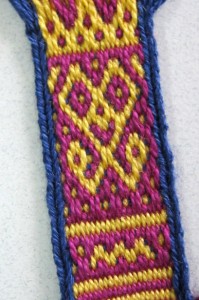 I took a wonderful class in Andean Pebble Weave in Tablet Weaving. This doesn’t involve a loom at all, threads are manipulated with cards with holes punched in them, and the yarn is weighted by stringing it between two c-clamps. I was curious about this application because I teach Andean Pebble Weave on the Inkle Loom. I was glad to have taken the class, because it reinforced what I was teaching, and on an inkle loom, the Pebble rows are instantly manipulated instead of having to manually rotate cards for each pair of threads. The teacher actually had a work station set up for each student so we could try it out.
I took a wonderful class in Andean Pebble Weave in Tablet Weaving. This doesn’t involve a loom at all, threads are manipulated with cards with holes punched in them, and the yarn is weighted by stringing it between two c-clamps. I was curious about this application because I teach Andean Pebble Weave on the Inkle Loom. I was glad to have taken the class, because it reinforced what I was teaching, and on an inkle loom, the Pebble rows are instantly manipulated instead of having to manually rotate cards for each pair of threads. The teacher actually had a work station set up for each student so we could try it out.
I took a class on three shaft weave structures. Few would call three shaft structures complex, but that’s unfortunate, because complex cloth isn’t about how many shafts you have. It is how they are manipulated and how far you can push the equipment you have. I enjoyed the class, it has been years since I attended a presentation that used an overhead projector. I’m surprised you can still buy those acetate sheets. The instructor, one of the most respected weavers I know, talked about being stuck on boat for a social outing for five hours and finding no knitting at hand, resorted to calculating how many different ways she could manipulate three shafts, scribbling down drafts on a cocktail napkin. I identify with that.
And I took a seminar on classification of weaving terms, which was really entertaining for me, I liken it to a bunch of botanists sitting in a room trying to assign latin names for all the common plants out there in the world. No latin involved, but the heated discussions on where to put a specific weave structure showed clearly the kind of knowledge and passion that permeated this conference. Knowledge and passion there was. I can’t think of another group like the Complex Weavers. This is a group of really really smart sharp minds, many very well educated, and intensely passionate about what they do. At times I felt like a fly on the wall, occasionally in over my head, but there was so much to learn and experience here that even the newest of weavers would be inspired and challenged to push past anything they ever thought possible.
There were tours associated with the conference, and I took advantage of one of them, the Dupont estate at Winterthur in DE. We were broken into small groups, and lead into rooms housing incredible textile collections to look at incredible textiles, no cameras, cellphones, or even purses allowed, but having a personal guide was a fantastic experience, and after cruising the gift shop and all the garden statuary, I came home with this…
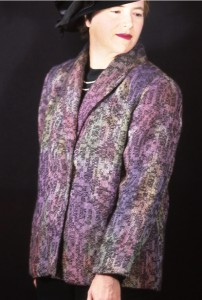
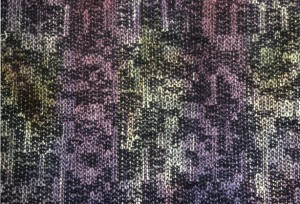 One final note, Chris Spangler, a fantastic digital Jacquard weaver from the DC area, handed me a disk, with images of a jacket I tailored for her from her fabric back in 1996. I had no recollection of this collaboration, until I saw the photos, and I know I made the jacket because there is a small scrap of this fabric in my attic. It is great to be reconnected with something you’d forgotten about in an earlier life. In my defense I would have had a three year old and a six year old at the time, I don’t remember much about that period.
One final note, Chris Spangler, a fantastic digital Jacquard weaver from the DC area, handed me a disk, with images of a jacket I tailored for her from her fabric back in 1996. I had no recollection of this collaboration, until I saw the photos, and I know I made the jacket because there is a small scrap of this fabric in my attic. It is great to be reconnected with something you’d forgotten about in an earlier life. In my defense I would have had a three year old and a six year old at the time, I don’t remember much about that period.
So now, I’m jumping into the week ahead, I have emails to answer, and orders to ship, I have looms to prepare for the Fiber Fallout, and warps to wind. I have a loom to warp for a Dianne Totten workshop my guild is sponsoring the beginning of October, on crimp cloth. And I have my extensive gardens to enjoy before they go to sleep for the winter, where my dog is eyeing warily this unknown creature happily grazing in my flower beds.
Stay tuned…
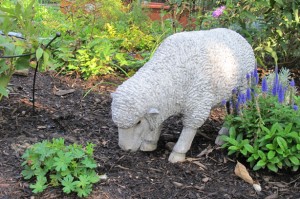
What a great blog! I felt like I got to be part of the event. Now I wish I had gone too but maybe next time….
Enjoyed your comments Daryl. I hope to get to one of these conferences in the future.
Thanks for the great wrap-up. Even tho I was there, it was interesting to read someone else’s take on the conference.
Great conference. I really enjoyed the fashion show. Your coat as always was wonderful, however, you should straighten the hem. It has grown in only some areas as handwovens sometimes do.
Curious Martha, I didn’t see that, since I was wearing it, does anyone have a photo of the hem of my coat with me in it? The coat is now on its way to North Carolina so I can’t check myself. The front collar rolls back down to the hem in an upward sweep, maybe you saw that?
I enjoyed teaching the pebble weave class at Complex Weavers and having you in my class. Thank you for the write-up.
A
Lost my “a”. Try again. As an advanced beginning weaver your comments on structure caught my eye. Does anyone have a graphic organizer that shows where different weave structures fit in the over-all picture of weaving? What weaves are considered plain weave? Twills? Where would overshot fit on such a chart? Or summer & winter weaves? Or will my questions resolve themselves when I have more experience weaving? I feel the need to know how to organize the different things I’ve read about before I choose what to try next.
Glad you are back before todays storm. Looks like it will be a goodun.
A whole class on 3 shaft structures…oooo. I need to work on that. This Winter I am absolutely committed to getting serious work done on my warp weighted loom.
I was in the weave classification class with Chris Spangler. We are working together to set up a study group in CW which will allow all of us to chime in on weave structure classification. So if you are interested in where a twill belongs or what to call summer and winter, check the CW site in a few weeks and hopefully the study group will be up and running.
Wow — so glad you had an opportunity to learn and take classes instead of leading them. Most of the topics are way over my head, but I’m constantly trying to understand structure and still don’t really get it. But, I’ll keep on trying! The classification stuff sounds interesting, too.
I, too, attended the seminars and had a fabulous time. As a first-timer, I found everyone very welcoming. The fun thing about a weaver’s conference is that no one really looks at your face – they look at and touch your scarf or jacket or vest and always offer wonderful comments about it. And the next day they don’t recognize you, but if you wear something different, they start all over again! Special thanks to Daryl for moderating the fashion show. You have a gift for making each “model” feel relaxed, and, of course, there were your wonderful garments to… Read more »
CWDC 2012 was wonderful!
meeting you in person was one of the meeting highlights for me! I am determined to find time before the end of the year to weave some Inkle yardage and to tackle the “Jacquard’ loom! that will happen if I can talk the HP printer into working right….
Wow . . . right now I’m wishing cash wasn’t so tight or I think I would go for a membership right now, I would love to get a hardcopy journal full of actual challenging weaving concepts! Seems like a much more worthwhile use of my cash than e.g. resubscribing to Handwoven!
You are right, it is delightful to teach one or two seminars and learn something different in the remaining seminar times. I find that there many people at CW Seminars are teachers someplace. In my seminars they want to learn new concepts and methods but they are also watching how I introduce a topic and how I explain things.
Daryl, it was great to see you at CW! I hope you can get to the next one in 2014. I am sure you have seen a lot of weavers fashion shows but probably not any quite like this one.
That was a really interesting report. I should join the Complex Weavers! I’ve ordered a 24 harness Little Weaver from AVL …. so I’m hoping to get to do some interesting things with it. But of course what this essay points out is that having lots of shafts isn’t the point, understanding the weave structures is. I have a lot of work to do.